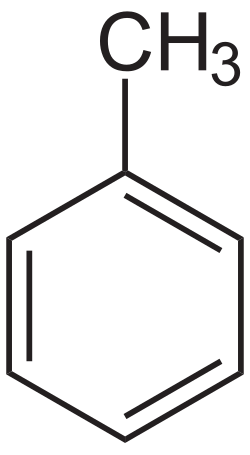Toluene toxicity

Editor-In-Chief: Prab R Tumpati, MD
Obesity, Sleep & Internal medicine
Founder, WikiMD Wellnesspedia &
W8MD medical weight loss NYC and sleep center NYC
| Toluene toxicity | |
|---|---|

| |
| Synonyms | Toluene poisoning |
| Pronounce | N/A |
| Specialty | N/A |
| Symptoms | Headache, dizziness, nausea, fatigue, confusion, ataxia, euphoria, seizures, coma |
| Complications | Liver damage, kidney damage, central nervous system depression |
| Onset | Minutes to hours after exposure |
| Duration | Variable, depending on exposure level and duration |
| Types | N/A |
| Causes | Inhalation, ingestion, or dermal exposure to toluene |
| Risks | Occupational exposure, substance abuse |
| Diagnosis | Clinical assessment, blood toluene levels, urinalysis |
| Differential diagnosis | Other solvent toxicity, alcohol intoxication, carbon monoxide poisoning |
| Prevention | Use of personal protective equipment, ventilation, substitution with less toxic substances |
| Treatment | Supportive care, oxygen therapy, activated charcoal for ingestion |
| Medication | N/A |
| Prognosis | Generally good with prompt treatment, but chronic exposure can lead to long-term effects |
| Frequency | Common in industrial settings and among substance abusers |
| Deaths | N/A |


Toluene Toxicity is a medical condition that arises from exposure to the chemical compound Toluene. Toluene is a colorless, water-insoluble liquid with the smell associated with paint thinners. It is a mono-substituted benzene derivative, consisting of a CH3 group attached to a phenyl group.
Causes[edit]
Toluene toxicity can occur through various routes such as inhalation, skin contact, and ingestion. The most common route of exposure is through inhalation of vapors from products containing toluene such as paint thinners, adhesives, and certain types of cleaners.
Symptoms[edit]
The symptoms of toluene toxicity can vary depending on the level and duration of exposure. Acute exposure can lead to symptoms such as confusion, dizziness, headache, and in severe cases, unconsciousness. Chronic exposure can lead to more serious health effects such as liver and kidney damage, hearing loss, and problems with the central nervous system.
Diagnosis[edit]
Diagnosis of toluene toxicity is often based on a combination of history taking, physical examination, and laboratory tests. The history should include questions about the patient's occupational and environmental exposures. Laboratory tests may include blood and urine tests to measure the levels of toluene and its metabolites.
Treatment[edit]
Treatment for toluene toxicity primarily involves removing the source of exposure and providing supportive care. In cases of acute exposure, this may involve moving the patient to fresh air and providing oxygen. In cases of chronic exposure, treatment may involve medications to manage symptoms and complications.
Prevention[edit]
Prevention of toluene toxicity involves proper handling and use of products containing toluene. This includes using these products in well-ventilated areas, wearing protective clothing and equipment, and following all safety instructions and precautions.
See Also[edit]
Ad. Transform your life with W8MD's Budget GLP-1 injections from $75


W8MD offers a medical weight loss program to lose weight in Philadelphia. Our physician-supervised medical weight loss provides:
- Weight loss injections in NYC (generic and brand names):
- Zepbound / Mounjaro, Wegovy / Ozempic, Saxenda
- Most insurances accepted or discounted self-pay rates. We will obtain insurance prior authorizations if needed.
- Generic GLP1 weight loss injections from $75 for the starting dose.
- Also offer prescription weight loss medications including Phentermine, Qsymia, Diethylpropion, Contrave etc.
NYC weight loss doctor appointmentsNYC weight loss doctor appointments
Start your NYC weight loss journey today at our NYC medical weight loss and Philadelphia medical weight loss clinics.
- Call 718-946-5500 to lose weight in NYC or for medical weight loss in Philadelphia 215-676-2334.
- Tags:NYC medical weight loss, Philadelphia lose weight Zepbound NYC, Budget GLP1 weight loss injections, Wegovy Philadelphia, Wegovy NYC, Philadelphia medical weight loss, Brookly weight loss and Wegovy NYC
|
WikiMD's Wellness Encyclopedia |
| Let Food Be Thy Medicine Medicine Thy Food - Hippocrates |
Medical Disclaimer: WikiMD is not a substitute for professional medical advice. The information on WikiMD is provided as an information resource only, may be incorrect, outdated or misleading, and is not to be used or relied on for any diagnostic or treatment purposes. Please consult your health care provider before making any healthcare decisions or for guidance about a specific medical condition. WikiMD expressly disclaims responsibility, and shall have no liability, for any damages, loss, injury, or liability whatsoever suffered as a result of your reliance on the information contained in this site. By visiting this site you agree to the foregoing terms and conditions, which may from time to time be changed or supplemented by WikiMD. If you do not agree to the foregoing terms and conditions, you should not enter or use this site. See full disclaimer.
Credits:Most images are courtesy of Wikimedia commons, and templates, categories Wikipedia, licensed under CC BY SA or similar.
Translate this page: - East Asian
中文,
日本,
한국어,
South Asian
हिन्दी,
தமிழ்,
తెలుగు,
Urdu,
ಕನ್ನಡ,
Southeast Asian
Indonesian,
Vietnamese,
Thai,
မြန်မာဘာသာ,
বাংলা
European
español,
Deutsch,
français,
Greek,
português do Brasil,
polski,
română,
русский,
Nederlands,
norsk,
svenska,
suomi,
Italian
Middle Eastern & African
عربى,
Turkish,
Persian,
Hebrew,
Afrikaans,
isiZulu,
Kiswahili,
Other
Bulgarian,
Hungarian,
Czech,
Swedish,
മലയാളം,
मराठी,
ਪੰਜਾਬੀ,
ગુજરાતી,
Portuguese,
Ukrainian


